 |
A visit to the BEDRUTHAN STEPS in Cornwall |
| Home Recommend This Site To A Friend |
|
by Sandy Leven.
On the cliffs before tea

The weather up until Easter 2003 has been better than for many years. It was just prefect for a visit to Cornwall, which is famed, for its magnificent gardens full of Rhododendrons, Camellias and Magnolias. I want to draw attention to the natural beauty of the Cornish Coast and just a few of its plants. Like the North West Coast of Scotland it is battered by strong winds from the Atlantic. Many of these coastal plants thus develop characteristics similar to mountain plants. They may be ground hugging, cushion shaped mounds or may have waxy or silver leaves. 
Much of the coastline, certainly the 'best bits' are in the care of The National Trust. Such a site is BEDRUTHAN STEPS a few miles North East of Newquay. The Shop and Information Centre provide a welcome haven, if the winds are strong, especially if it is wet as well, and Car Park has picnic tables. There is a superb walk from the car park to the beach. "Huge pinnacles of wave lashed rocks far below towering cliffs. If you have the time, and the tide is out and sea calm it is a nice walk along the beach, the steep climb back up the steps is also memorable." Unforgetable! Parts of the land are covered with gorse but most is grassland. 
The descent is at first gentle until the path reaches the cliff edge when it plunges down steep, damp steps through a cleft down to a small bay. The path follows a dry stane dyke, which in the Cornish fashion is made up of two walls filled with in which grows a range of plants. 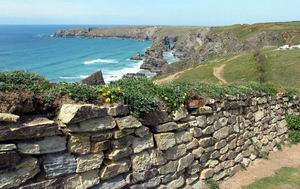
Silene maritima tumbled over the sheltered side of the wall, its pretty white flowers just catching the sunshine. Here all the plants I saw were white flowered but on the Berwickshire coast nice pink forms occur. Silene takes its name from 'Silenus', the drunken, merry god of the woodlands in Greek mythology. 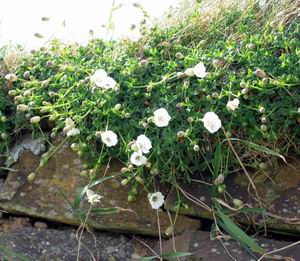
Anthyllis vulnerata is new to me [ although I am familiar with a vermillion red Anthyllis ], probably because I don't live by the sea. It resembles a large Bird's Foot Trefoil. Inland it is an upright plant but here by the sea it was flat on the ground. It is pollinated by Bumble Bees. The flowers in the head go brown as they age. The interesting leaves appear silky underneath. The terminal leaflet is bigger than the others. It used to be used for healing wounds, hence its specific name from the Latin 'vulnus' - a wound. 
Also growing in wall and looking quite superb Cochlearia officinalis a common plant of seaside places. Colloquially known as scurvy grass because of the high Vitamin C content of its fleshy leaves, it scored high points for presentation in its niches in the dyke. In the 17th Century it was fashionable to drink a glass of scurvygrass water every morning! 
Thrift is one of the commonest plants in rocky seaside places. It is also one of my favourite plants. I never tire of seeing its fresh pom-poms standing firm above its grassy cushions. On the steep sides of the steps leading down to the beach it seemed to be a prisoner behind chain link fencing but was establishing its independence by growing through the mesh. Large clumps grew beside the coastal path. 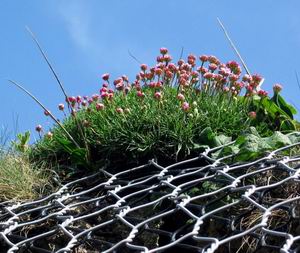

Down in the bay pinnacles of rock broke the Atlantic rollers as they pounded the beach. At low tide instaed of rock plant you can examine rock animals. The rocks are covered with mussels. 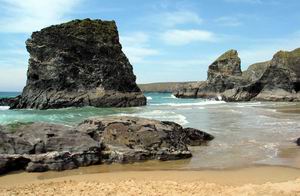
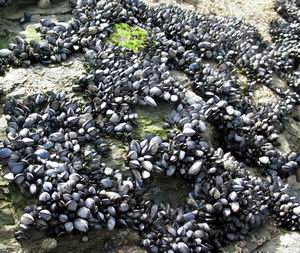
Once down at sea level I stopped being a rock gardener and in my mind became a smuggler. You could imaging shipwrecks in the bay and teams of men carrying booty up the cliffs and away to the hinterland. There as even a cave which led out into another bay, so that you could escape from the revenue men. 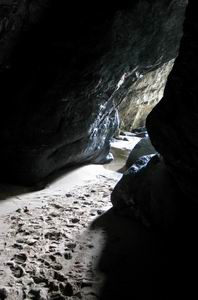
The climb up the steps was easier than I imagined it would be, probably because I was getting super fit! A glance back along the cliff top recorded the beauty of the bay with its pinnacles and cliff top plants. I had hoped to fine Scilla verna, which I had previously seen near Land's End but perhaps it was over. King Arthur's Castle of Tintagel is a few miles further up the coast. Also in the care of the National Trust it has even scarrier steps to negotiate. Best to stop in the village for a cream tea before attempting to reach that castle. 
|